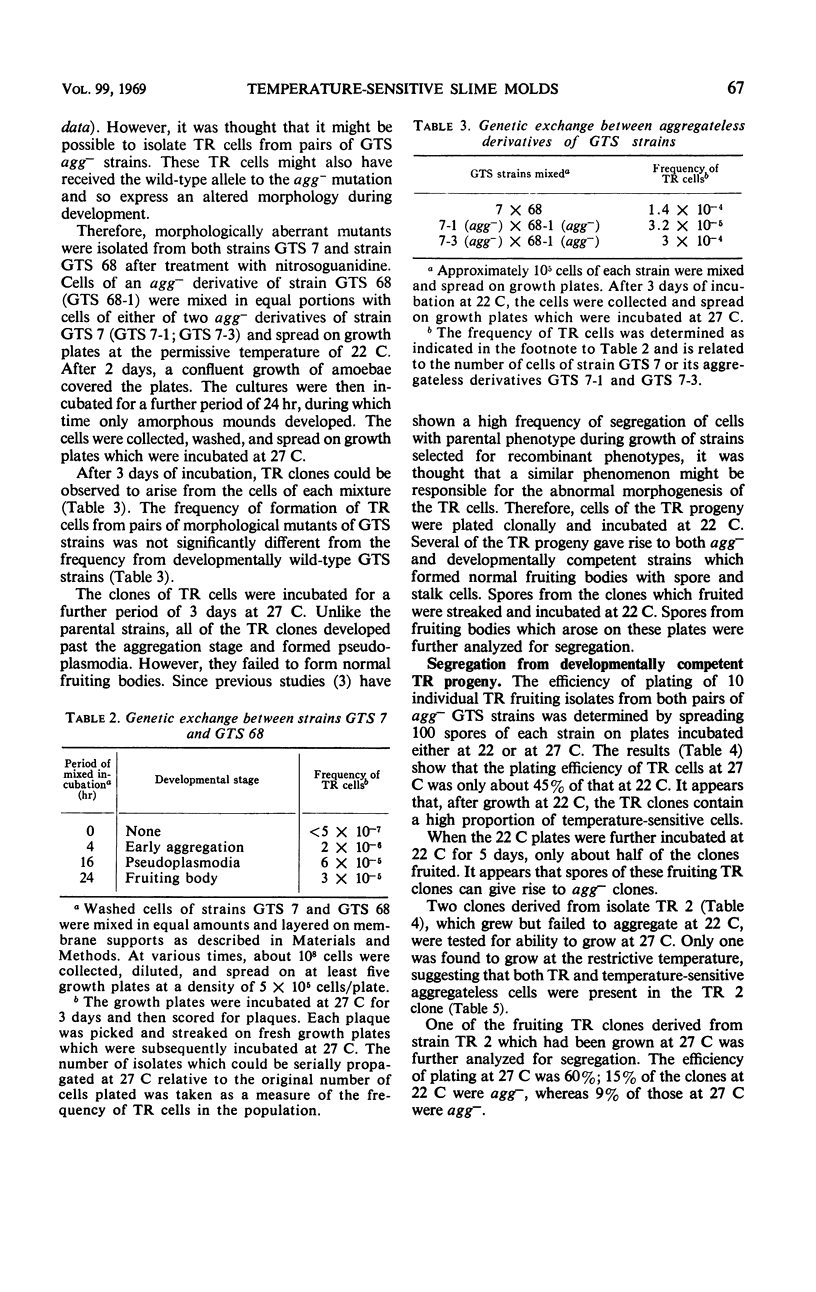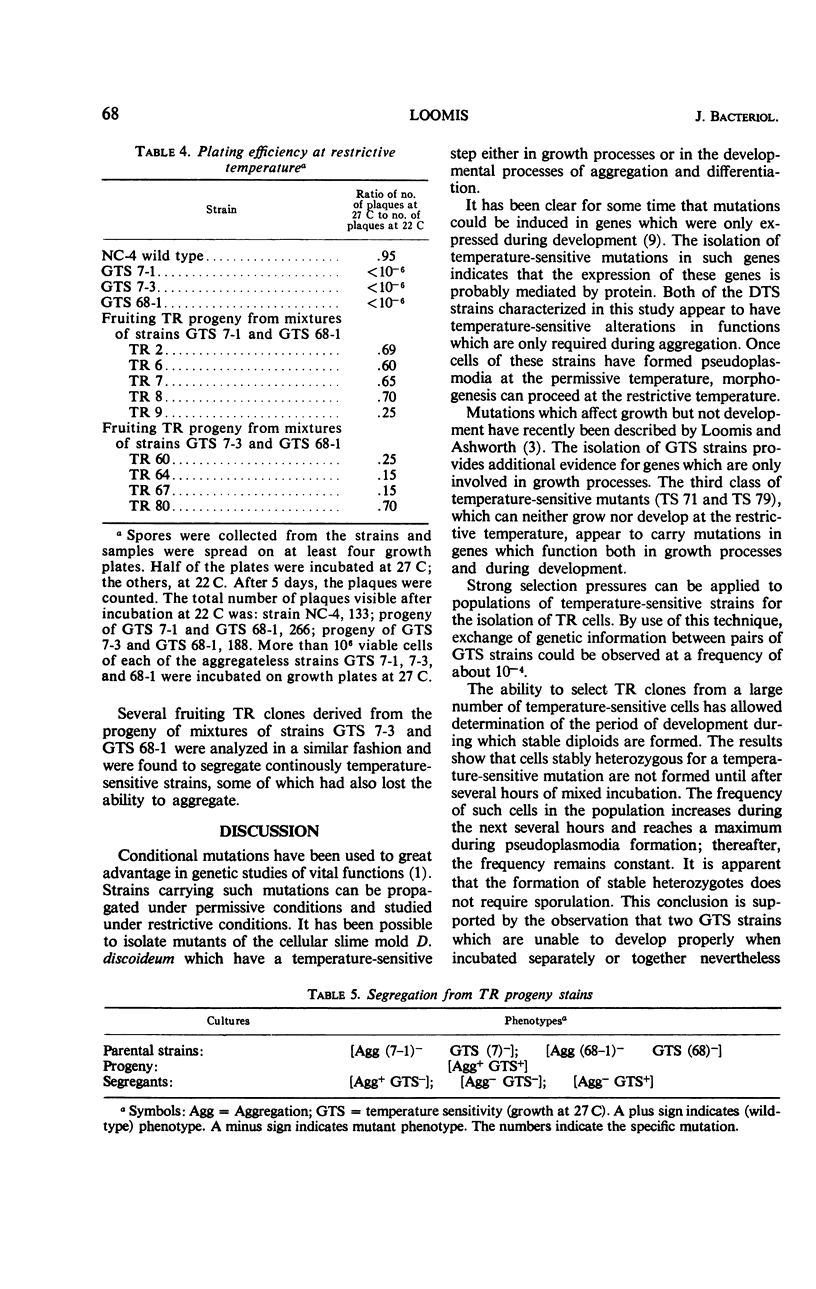Abstract
Three classes of temperature-sensitive mutants of the cellular slime mold Dictyostelium discoideum have been isolated. One class contains strains able to grow at 22 C but not at 27 C. Cells of these strains can develop into sorocarps at both temperatures. Another class contains strains which can grow at both temperatures but can only develop at the lower temperature. The third class contains strains unable to grow or develop at 27 C. Those strains whose development is temperature-sensitive appear to carry mutations which affect the cells only during the period of aggregation before the construction of a multicellular sorocarp. When pairs of growth-temperature-sensitive (GTS) strains develop in mixed aggregates, temperature-resistant (TR) cells are formed at a frequency of about 10−4. These TR cells transmit the phenotype in a relatively stable hereditary fashion. However, temperature-sensitive segregants can be isolated from TR strains even after six clonal passages. Mixed incubation of pairs of morphologically aberrant GTS strains was found to give rise to TR progeny which develop normally. These progeny clones independently segregate morphologically aberrant strains and temperature-sensitive strains. The results indicate that several temperature-sensitive and morphological mutations are recessive and nonidentical.
Full text
PDF




Selected References
These references are in PubMed. This may not be the complete list of references from this article.
- HUFFMAN D. M., KAHN A. J., OLIVE L. S. Anastomosis and cell fusions in Dictyostelium. Proc Natl Acad Sci U S A. 1962 Jul 15;48:1160–1164. doi: 10.1073/pnas.48.7.1160. [DOI] [PMC free article] [PubMed] [Google Scholar]
- Loomis W. F., Ashworth J. M. Plaque-size mutants of the cellular slime mould Dictyostelium discoideum. J Gen Microbiol. 1968 Sep;53(2):181–186. doi: 10.1099/00221287-53-2-181. [DOI] [PubMed] [Google Scholar]
- PONTECORVO G. The parasexual cycle in fungi. Annu Rev Microbiol. 1956;10:393–400. doi: 10.1146/annurev.mi.10.100156.002141. [DOI] [PubMed] [Google Scholar]
- SUSSMAN R. R., SUSSMAN M. Cellular differentiation in dictyosteliaceae; heritable modifications of the developmental pattern. Ann N Y Acad Sci. 1953 Oct 14;56(5):949–960. doi: 10.1111/j.1749-6632.1953.tb30274.x. [DOI] [PubMed] [Google Scholar]
- SUSSMAN R. R., SUSSMAN M. Ploidal inheritance in the slime mould Dictyostelium discoideum: haplodization and genetic segregation of diploid strains. J Gen Microbiol. 1963 Mar;30:349–355. doi: 10.1099/00221287-30-3-349. [DOI] [PubMed] [Google Scholar]
- Weiss M. C., Green H. Human-mouse hybrid cell lines containing partial complements of human chromosomes and functioning human genes. Proc Natl Acad Sci U S A. 1967 Sep;58(3):1104–1111. doi: 10.1073/pnas.58.3.1104. [DOI] [PMC free article] [PubMed] [Google Scholar]
- Yanagisawa K., Loomis W. F., Jr, Sussman M. Developmental regulation of the enzyme UDP-galactose polysaccharide transferase. Exp Cell Res. 1967 May;46(2):328–334. doi: 10.1016/0014-4827(67)90070-5. [DOI] [PubMed] [Google Scholar]


